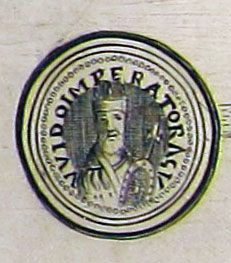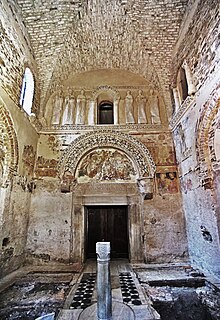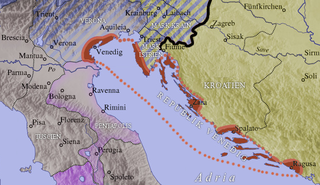History
After Charlemagne had conquered the Italian Kingdom of the Lombards under King Desiderius at the Siege of Pavia in 774, he at first allowed the Lombard duke Hrodgaud to continue ruling in Friuli. Charlemagne attached the March of Istria to Friuli. According to the Royal Frankish Annals, Hrodgaud two years later revolted declaring himself a King of the Lombards, whereafter Charlemagne came rushing into Italy where he routed the duke's forces and had him deposed and killed. The autonomous Lombard duchy was dissolved and incorporated into Francia. From 776, Friuli was ruled by Frankish appointees, who continued to bear the title of a dux Foroiuliensis. To the former Lombard duchy he added Pannonia as an integral part of his Carolingian Empire and a bulwark against the encroachments of the Avars and the Croats.
In February 828 the last Friulian dux, Baldric, was removed from office by Emperor Louis the Pious at the Imperial diet of Aachen, as he had not been able to defend the Pannonian frontier against the troops of Khan Omurtag of Bulgaria. The duchy was divided into four counties, which in 846 were gathered together again as part of the Middle Frankish realm ruled by Louis' eldest son Emperor Lothair I. He bestowed Friuli on his brother-in-law Eberhard, of the Frankish Unruochings, with the title of dux, though his successors were called marchio: "margrave."
Eberhard's son Berengar, Friulian margrave since 874, was elected King of Italy after the deposition of Charles the Fat in 887. His election precipitated decades of contests for the throne between rival claimants. Berengar paid homage to the East Frankish king Arnulf of Carinthia, he nevertheless lost the crown to Duke Guy III of Spoleto in 889 and did not succeed in recapturing it until 905. Meanwhile, represented by his counsellor Walfred at the city of Verona, he remained master in Friuli, which was always the base of his support. After Berengar's death in 924, his partisans elected Hugh of Arles king.
King Hugh did not appoint a new margrave and the march lay vacant. It remained a political division of the Frankish Kingdom of Italy until the usurpation of the throne by Berengar II upon the death of Hugh's son King Lothair II in 950. Summoned by Lothair's widow Adelaide of Burgundy, the German king Otto I took the chance to conquer Italy, depose Berengar II and to marry Adelaide. The conflict was settled at the 952 diet of Augsburg, where Berengar II was allowed to retain the royal title as a German vassal, but had to cede Friuli as the March of Verona to Duke Henry I of Bavaria, brother of King Otto I. On February 2, 962 Otto was crowned Holy Roman Emperor at Rome, deposed King Berengar II and had him arrested and exiled one year later. His remaining Italian kingdom became a constituent part of the Holy Roman Empire.
The Veronese march was held by the Carinthian dukes from 976 well into the High Middle Ages. In 1077 King Henry IV of Germany vested the Patriarchate of Aquileia with the Friulian territory east of the Tagliamento river.

Lotharingia was a short-lived medieval successor kingdom of the Carolingian Empire. As a more durable later duchy of the Ottonian Empire, it comprised present-day Lorraine (France), Luxembourg, Saarland (Germany), the eastern half of Belgium and the southern half of Netherlands, along with parts of today's North Rhine-Westphalia (Germany), Rhineland-Palatinate (Germany) and Nord (France). It was named after King Lothair II, who received this territory after his father Lothair I's kingdom of Middle Francia was divided among his three sons in 855.

King of Italy was the title given to the ruler of the Kingdom of Italy after the fall of the Western Roman Empire. The first to take the title was Odoacer, a barbarian military leader, in the late 5th century, followed by the Ostrogothic kings up to the mid-6th century. With the Frankish conquest of Italy in the 8th century, the Carolingians assumed the title, which was maintained by subsequent Holy Roman Emperors throughout the Middle Ages. The last Emperor to claim the title was Charles V in the 16th century. During this period, the holders of the title were crowned with the Iron Crown of Lombardy.

The Duchy of Spoleto was a Lombard territory founded about 570 in central Italy by the Lombard dux Faroald. Its capital was the city of Spoleto.

The Duchy of Bavaria was a frontier region in the southeastern part of the Merovingian kingdom from the sixth through the eighth century. It was settled by Bavarian tribes and ruled by dukes (duces) under Frankish overlordship. A new duchy was created from this area during the decline of the Carolingian Empire in the late ninth century. It became one of the stem duchies of the East Frankish realm which evolved as the Kingdom of Germany and the Holy Roman Empire.

Berengar I was the king of Italy from 887. He was Holy Roman Emperor between 915 and his death in 924. He is usually known as Berengar of Friuli, since he ruled the March of Friuli from 874 until at least 890, but he had lost control of the region by 896.

Berengar II was the King of Italy from 950 until his deposition in 961. He was a scion of the Anscarid and Unruoching dynasties, and was named after his maternal grandfather, Berengar I. He succeeded his father as Margrave of Ivrea around 923, and after 940 led the aristocratic opposition to Kings Hugh and Lothair II. In 950 he succeeded the latter and had his son, Adalbert crowned as his co-ruler. In 952 he recognised the suzerainty of Otto I of Germany, but he later joined a revolt against him. In 960 he invaded the Papal States, and the next year his kingdom was conquered by Otto. Berengar remained at large until his surrender in 964. He died imprisoned in Germany two years later.

Guy III of Spoleto was the margrave of Camerino from 880 and then duke of Spoleto and Camerino from 883. He was crowned king of Italy in 889 and emperor in 891. He died in 894 while fighting for control of the Italian Peninsula.

The Kingdom of Upper Burgundy was a Frankish dominion established in 888 by the Welf king Rudolph I of Burgundy on the territory of former Middle Francia. It grew out of the Carolingian margraviate of Transjurane Burgundy southeast of ('beyond') the Jura Mountains together with the adjacent County of Burgundy (Franche-Comté) in the northwest. The adjective 'upper' refers to its location further up the Rhône river, as distinct from Lower Burgundy and also from the Duchy of Burgundy west of the Saône river. Upper Burgundy was reunited with the Kingdom of Lower Burgundy in 933 to form the Kingdom of Burgundy, later known as Kingdom of Arles or Arelat.
The dukes and margraves of Friuli were the rulers of the Duchy and March of Friuli in the Middle Ages.
Eric was the Duke of Friuli from 789 to his death. He was the eldest son of Gerold of Vinzgouw and by the marriage of his sister Hildegard the brother-in-law of Charlemagne.

The Duchy of Friuli was a Lombard duchy in present-day Friuli, the first to be established after the conquest of the Italian peninsula in 568. It was one of the largest domains in Langobardia Major and an important buffer between the Lombard kingdom and the Slavs, Avars, and the Byzantine Empire. The original chief city in the province was Roman Aquileia, but the Lombard capital of Friuli was Forum Julii, modern Cividale.

The March of Tuscany was a frontier march of the Kingdom of Italy and the Holy Roman Empire during the Middle Ages. Located in northwestern central Italy, it bordered the Papal States to the south, the Ligurian Sea to the west and Lombardy to the north. It comprised a collection of counties, largely in the valley of the Arno River, originally centered on Lucca.
The Unruochings were a Frankish noble family who established themselves in Italy. The family is named for the first member to come to prominence, Unruoch II of Friuli.

The March of Verona and Aquileia was a vast march of the Holy Roman Empire in northeastern Italy during the Middle Ages, centered on the cities of Verona and Aquileia. Seized by King Otto I of Germany in 952, it was held by the Dukes of Bavaria; from 976 in personal union with the Duchy of Carinthia. The margravial regime ended with the advent of the Lombard League in 1167.

The March of Istria was originally a Carolingian frontier march covering the Istrian peninsula and surrounding territory conquered by Charlemagne's son Pepin of Italy in 789. After 1364, it was the name of the Istrian province of the Habsburg Monarchy, the Austrian Empire and Austria-Hungary.

The Margraviate of Austria was a medieval frontier march, centered along the river Danube, between the river Enns and the Vienna Woods (Wienerwald), within the territory of modern Austrian provinces of Upper Austria and Lower Austria. It existed from c. 972 to 1156.

Carnia is a historical-geographic region in the northeastern Italian area of Friuli. Its 27 municipalities all belong to the Province of Udine, which itself is part of the autonomous Friuli-Venezia Giulia region.

Otto I, traditionally known as Otto the Great, was East Francian king from 936 and Holy Roman Emperor from 962 until his death in 973. He was the oldest son of Henry I the Fowler and Matilda.
Milo was the Count of Verona from 931 until 955. He was a vassal of four successive kings of Italy from 910. Under Berengar I he became a courtier (familiaris) and by 924 head of the bodyguard. By 927 he had expanded his landholdings to have vassals of his own. Under Hugh, he revolted twice but kept his position in Verona. Under Berengar II, he was raised to the rank of margrave (marchio) in 953.














